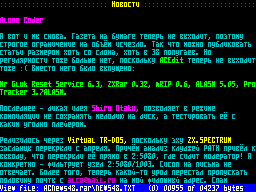|
21 января 2016 |
|

How to convert gfx for colour-per-pixel mode by Alone Coder I was asked a question, how to convert gfx to "EGA" mode of ATM Turbo. If you want just a photo with dithering: 1. Tune up brightness/contrast/saturation more vivid. 2. In Photoshop, convert to adaptive palette of ~30 colours. Don't apply this palette though. Do edit it. 3. Change every color by hand to match ATM Turbo's colours (i.e. with components equal to 0/85/170/255 - howeverLVDmeasures there 0/93/162/255, but I'm not sure the authors of ATM Turbo wanted these exact values; the difference is subtle though). If there is uncertainty how to round - make a couple of versions of the colour (anyway the palette will have a lot of identical colours). 4. See how many colours we get (apply, convert to RGB, then to "exact" palette). If there are less than 16, add colour variants. If there are more, remove the rare shades (if they can be simulated with dithering). 5. Apply the palette. Try dithering between 30% and 100%. 6. Convert to RGB. 7. Convert to "exact" palette - 16 colours. 8. Save as a 4-bit BMP. While you select a palette, you can time to time save it, apply, undo the result... Hippiman suggests the following method: ───────────────────────────────────────────────────────────────┐ You must reduce the number of colour in the image to the minimum. The best way is to do it gradually, in few steps. First, experimentally convert the image to "adaptive" palette with almost the original quality. Generally there are 60 to 70 colours. Then "join" the similar colours, possibly to ATM colours. Try to avoid small areas of rare colours. Then convert to RGB and repeat many times, until you have around 30 colours. ───────────────────────────────────────────────────────────────┘ If you have to convert pixel art (as in Nedodemo 2 ), there is more to do. You must try by hand several versions of colour grades for each of the colour grades of the original palette. Sometimes you must lose one colour or two (join it with another). If you need 50% textures, first convert the picture to ~30 colours with components 0/42/85/128/170/212/255, then find an ATM Turbo palette that covers all of your colours with 50% textures, then convert every colour area to 50% texture (not all at once - Photoshop can't make a clear 50% texture everywhere). I found no better method than to copy the area to another document (initially white) then setting a 3-colour palette (white plus two colours, the given colour must be exactly in the middle between them) then apply with diamond dithering. Then copy the converted area back to the original picture. Converting toDDp's palette (RЧGЧB4) is easier - just apply the "adaptive" palette and save. When you remove the least significant bits, there will be a little difference. If you want it better, correct the "adaptive" colours by hand before you apply them. DiHalt Visitors' software for group conversion of BMPs to packed memory dumps is there: http://alonecoder.nedopc.com/zx/convega.rar There is also a special utility byTmK that converts a picture to two flickering screens, colour-per-pixel. However it can't find the best palette
Other articles:
|
|
|
|
|
|
|
|
|
|
|
|
Similar articles:
В этот день... 17 December